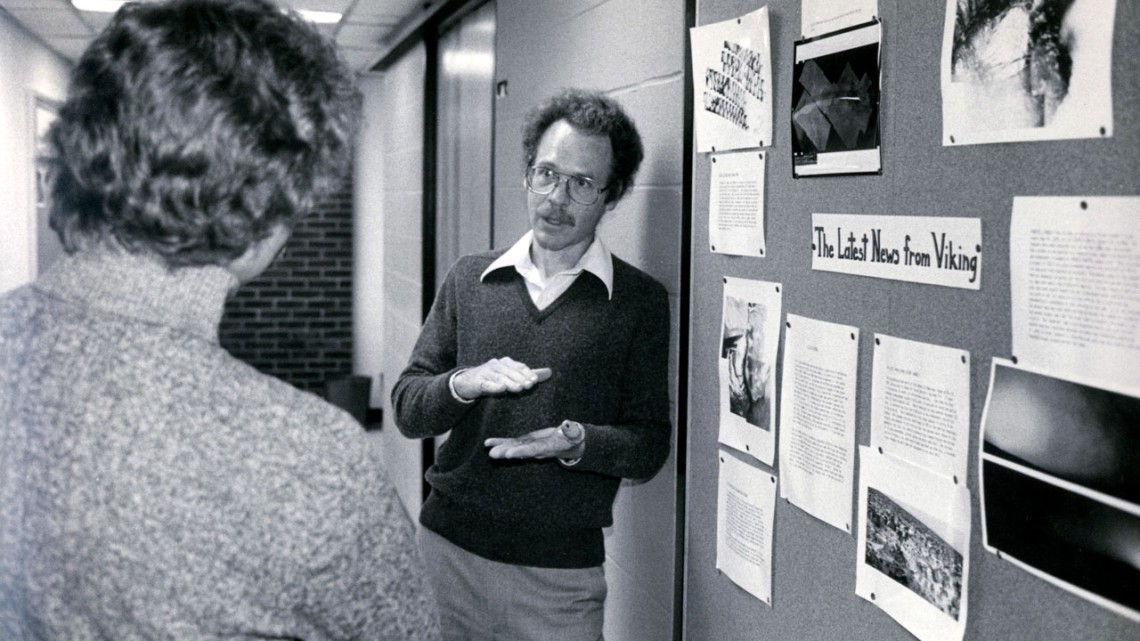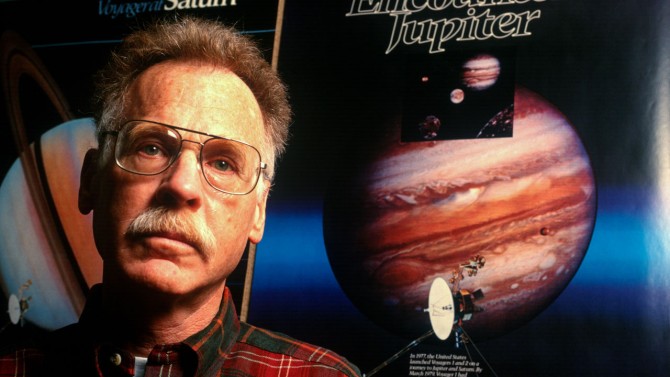
Famed Cornell astronomer Peter Gierasch, seen here in 1979, died Jan. 20 in Ithaca. He was 82.
Peter Gierasch, planetary astronomer, dies at 82
By Blaine Friedlander, Cornell Chronicle
Peter Gierasch, a Cornell astronomer whose mathematical models unveiled the turbulent vortices, tempestuous eddies and atmospheric tumult arising on other worlds – long before spacecraft could consistently prove it with images – died Jan. 20 in Ithaca. He was 82.
Gierasch, a professor emeritus of astronomy in the College of Arts and Sciences, contributed to a wealth of knowledge on the processes of planetary atmospheres – specifically Mars, Venus, Jupiter and Saturn’s largest moon, Titan. He served as a team scientist on the Viking, Pioneer, Voyager, Galileo and Cassini missions for NASA.
“Peter is truly one of the leading people who have developed almost everything we know today about the atmospheres of planets, other than the Earth," said Joseph Veverka, the James A. Weeks Professor of Physical Sciences emeritus (A&S).
Gierasch was known for his amazing mathematical ability. “With models, he could predict things before they were seen, but he did take advantage of observation,” Veverka said. “He was able to explain the strange things that were seen in spacecraft images.”
As a freshly minted Ph.D., Gierasch published a 1968 paper on Martian thermal and dynamical structure, which was the first to systematically consider the surface-atmosphere (wind-driven) interaction occurring on Mars and how it fundamentally differed from Earth.
Gierasch, Veverka and the late Cornell astronomer Carl Sagan published a detailed paper on Martian winds in 1971 that proved accurate when rovers visited the red planet about three decades later.
His next groundbreaking 1975 finding focused on Venus’ atmospheric rotation, where he showed how the planet’s equatorial atmospheric region moved much faster than the rest of the planet’s atmosphere. This process – an angular-momentum surplus that contributes to atmospheric super rotation – is now known as the Gierasch Mechanism. Subsequently, this process was discovered again on the large Saturnian moon Titan.
Gierasch’s impact on examining planetary atmospheres is exceptional, according to a citation when he received the 2014 Gerard P. Kuiper Prize, the highest honor bestowed by the Division for Planetary Sciences of the American Astronomical Society. Other notable Kuiper Prize winners include Veverka and Sagan. His publication record and citations were outstanding, according to the group, “Most of all, his publications have had a lasting effect on atmospheric science, with some of his early papers still being frequently cited today, decades after their publication.”
Gierasch also examined the atmospheres of giant planets. A 1986 paper looked at temperatures as a function of latitude and altitude on Jupiter, as he inferred the atmospheric circulation that those temperatures required. This led to a theory of belts and zones, churning above the clouds in Jupiter’s upper troposphere. NASA’s Juno spacecraft mission to Jupiter – which arrived in 2016 -- confirmed the concepts.
“Peter was very quick, facile and capable with the differential equations of fluid mechanics and radiative transfer,” said Don Banfield ’87, who would become a postdoctoral researcher working alongside Gierasch. Banfield is now a senior visiting scientist at the Cornell Center for Astrophysics and Planetary Science. “He would think in those equations very efficiently. He could boil it down on how Jupiter’s atmosphere works or how the winds blow on Mars.”
Banfield said that Gierasch was quick to understand the physics and work the math correctly to make an accurate prediction. “He would be the right person to consult about where to send exploratory spacecraft,” he said.
Peter Jay Gierasch was born in Washington, D.C. on Dec. 19, 1940. He graduated from Wayland High School, Wayland, Massachusetts – just outside Boston. He earned both his bachelor’s degree (1962) and his Ph.D. (1968) from Harvard University. His first academic position was at Florida State University in Tallahassee.
Gierasch joined the Cornell faculty in 1972 and he served for a decade as director of the Cornell Center for Radiophysics and Space Research. He was an Alfred P. Sloan Foundation Research Fellow from 1975 to 1979.
Gierasch would run several miles daily around the Cornell campus – mostly alone – “to think ideas through,” he would say. He ran the annual Skunk Cabbage Classic race in Ithaca and he ran in the Boston Marathon.
Students appreciated his thoughtfulness. “Peter was gentle and generous,” Banfield said. “If someone came to him with a concern, whether professional or personal, Peter would take the time to listen – usually mostly listening as opposed to lecturing.”
For his 60th birthday celebration at Cornell, the International Astronomical Union formally named an asteroid – 5153 Gierasch – in his honor. The asteroid, measuring 17 miles in diameter, was discovered on April 9, 1940, in Turku, Finland by Yrjö Väisälä, a noted Finnish astronomer.
He is survived by his wife Maida; son Adam, of Los Angeles; daughter Amanda, of Adelaide, Australia; sister Molly Gierasch, of Durango, Colorado; sister Lila Gierasch, of Ashield, Massachusetts; two granddaughters; and a niece.
A memorial service will be held at a later date.
Media Contact
Get Cornell news delivered right to your inbox.
Subscribe

